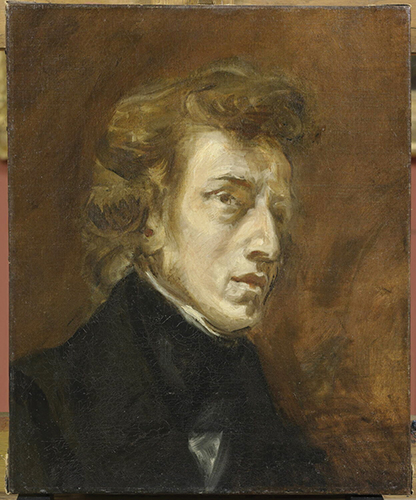FRYDERYK FRANCISZEK CHOPIN
TIMELINE
| 1810 | Born in Żelazowa Wola, nr. Warsaw, Poland, March 1, 1810. Family moves to Warsaw in October |
| 1816 | First piano lessons from his mother, then from Adalbert Żywny, until he was 12 |
| 1817 | First Polonaise, in G minor published |
| 1818 | Charity concert in Warsaw, then many recitals in aristocratic homes |
| 1822 | First composition lessons, from Józef Elsner |
| 1824 | Enrolls at Warsaw Lyceum, where his father teaches. Begins to study harmony |
| 1825 | Plays before Tsar Alexander I, who gives him a diamond ring. Publishes his Op. 1 (Rondo in C minor) |
| 1826 | Enters Warsaw Conservatory |
| 1828 | Visits Berlin |
| 1829 | Graduates. Final report: “Chopin F., third-year student, exceptional talent, musical genius.” Two successful concerts in Vienna. Completes first piano concerto. Declares his infatuation for singer Konstancja Gładkowska |
| 1830 | Completes a second piano concerto. Plays both at his first public concerts in Warsaw. Leaves Poland for Austria, France and Italy |
| 1831 | Unproductive time in Vienna. Homesick. Hears of Warsaw’s defeat by Russians. Writes the first nine of almost 60 mazurkas, music that captures his innermost feelings. Arrives in Paris in October |
| 1832 | First Paris concerts. Feels at home in Paris among Polish émigrés, if not on the competitive concert stages. Begins a lucrative teaching career to the aristocracy. Publishes Op. 9 Nocturnes |

Chopin’s birthplace, Żelazowa, now a museum
| 1833 | Joint concert with Liszt. Friendship with Bellini, Mendelssohn, Berlioz. Warm critical reception to the young Pole from the critics |
| 1834 | Earliest Nocturnes and other works (Opp. 8 – 19) now published simultaneously in France, Germany and England. Composes large-scale compositions like First Scherzo and Ballade rather than salon pieces |
| 1835 | Falls in love with Maria Wodzińska. Visits Schumann in Leipzig. Falls seriously ill in Heidelberg. Rumors of his death |
| 1836 | Marriage proposal to Maria (17) accepted, but family forces secrecy. Meets George Sand. “What an unattractive person La Sand is. Is she really a woman?” he says |

Chopin at 23
| 1837 | Engagement severed by Maria’s family. Visits London, though increasingly declines concerts, viewing himself as composer, rather than pianist-composer. Focuses on Nocturnes, Op. 32, Second Scherzo, Études, Op. 25 |
| 1838 | Begins 10-year liaison with Sand. Disastrous winter together in Mallorca. Completes Preludes Op. 28 in Valldemossa |
| 1839 | A seriously ill Chopin and the Sand family leave Mallorca. Summer in Nohant, Sand’s country home in France. Finishes B-flat minor Sonata, Mazurkas Op. 41, Nocturne Op. 37 No. 2 |
| 1840 | Entire year in Paris, composing in the day in his own apartment, other hours with Sand in Pigalle |
| 1841 | Glittering concert in April. Productive Summer in Nohant culminates in completion of Op. 48 Nocturnes, A-flat Ballade and F minor Fantaisie, Op. 49 |
| 1842 | Another productive summer in Nohant, partly in the company of French artist Eugène Delacroix, culminates in Mazurkas, Op. 50 and other major works |
| 1843 | Continues his practice of summer composition in Nohant, teaching and socializing the rest of year in Paris. Withdraws from concert life for five years |
| 1844 | Father dies. Completes Nocturnes Op. 55 |

Chopin watercolor by his love and pupil Maria Wodzińska, 1835. Chopin kept Maria’s letters for the rest of his life, labelled Moja Bieda (My Misery)
| 1845 | His own health again deteriorates. His sister Ludwika’s visit brings solace. A major rift in his relations with Sand develops |
| 1846 | Family tensions compound the rift. Sand’s novel Lucrezia Floriana, a ‘portrait’ of the Sand-Chopin relationship, adds fuel to the fire. Completes his final Nocturnes, Op. 62, Polonaise-fantaisie, Op. 61, and Cello Sonata, Op. 65 |
| 1847 | Chopin sides with Sand’s daughter Solange in entangled family relations, breaking with Sand. She describes it as “a strange conclusion to nine years of exclusive friendship.” |
| 1848 | Gives a final Paris concert. Concerto tour and exhausting social round in England and Scotland under the guidance and sponsorship of a pupil, Jane Stirling, exhaust him further. Weighing less than 99 lbs., Chopin returns to Paris. |
Portion of the unfinished 1838 Delacroix portrait of Chopin and Sand
| 1849 | Stirling offers more financial assistance. Ludwika and family arrive to nurse him through the summer. Chopin spends his final days in new rooms in the Place Vendôme where, celebrated singer Pauline Viardot remarks, “all the fashionable Parisian ladies considered it de rigueur to faint in his room.” Chopin dies there October 17, aged 39. At his own request, his heart is sent in an urn to Warsaw where it rests to this day. More than 3,000 invited guests attended his funeral at the Church of the Madeleine. |

Chopin's death mask
